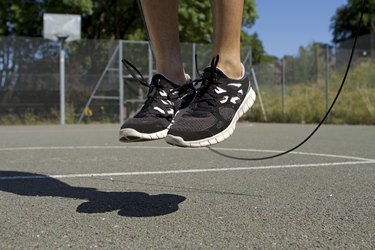
If you want to clear a hurdle, dunk a ball or improve your jeté, increasing your vertical jump is a must. Plyometric exercises, first used by Olympians in the 1970s, involve a slight muscular stretch, followed by a quick and explosive contraction. Plyometrics increase jumping height while building muscular strength. It's best to do plyometrics under proper supervision and after establishing a baseline of muscular strength. Incorrect form or insufficient strength can lead to injury.
Reach High
Video of the Day
Jumping squats strengthen the quads, glutes and hamstrings. Stand up straight, feet shoulder-width apart, and bend your knees slightly. Contract your stomach muscles, align your knees and ankles, and stick your butt out behind you. Swing your arms behind you and lower your hips toward the ground. Stop when your hamstrings are parallel to the floor. Push through your heels and swing your arms overhead while jumping as high as possible. Land softly on the middle of your feet, then slowly shift your weight onto your heels. Complete eight to 15 repetitions, stopping when your lower body fatigues.
Video of the Day
Lunge to a New Height
Jumping lunges build power in your legs, hips and glutes. Stand up straight, feet shoulder-width apart. Extend your left foot behind you and lift onto your toes. Position your right knee above your right ankle and maintain alignment throughout the lunges. Improper alignment, including pushing your knee past your toes, stresses the knee and may cause injury. Lower your hips to the ground, forming a 90-degree angle with your right leg. Stop before your left knee touches the ground. Push through your right heel, jump up and switch the position of your feet. Do a lunge with your left leg, jump and switch feet to complete the first rep. Focus on form rather than speed. Increase your height and velocity after you master correct form. Complete eight to 15 repetitions.
Turn it Out
The plié jump strengthens the glutes, legs and abs. The variation in squat stance recruits your muscles differently than during jump squats. It emphasizes and strengthens your inner thighs. Stand up straight, position your feet slightly wider than shoulder width and bend your knees slightly. Turn your toes out 45 degrees and stick your butt out behind you. Clasp your hands, place them in front of your chest and lift your elbows parallel to the floor. Lower your hips toward the floor, stopping when your hamstrings are parallel to the floor. Push through your heels, jump up as high as you can and tap your heels together. Land softly in the plie position, shifting your weight to your heels. Repeat for about 45 seconds, stopping when your legs fatigue.
Grab a Trainer
Lateral jumps on an inflatable balance trainer build explosive power in the legs, thighs, glutes and abs. Stand with your right side about 6 inches away from the trainer. Straighten your back, contract your abdominal muscles and pull your shoulder blades down and together. Align your knees and ankles. Lower your hips toward the floor, stopping when your hamstrings are parallel to the floor. Push through your heels, jumping to your right while keeping your feet parallel to the floor. Land softly on the middle of the balance trainer. Focus on landing on the middle of your feet and maintaining knee and ankle alignment. Lower into a squat, then jump to the right of the trainer and land softly on the ground. Squat, jump to your left and continue this pattern eight to 15 more times.